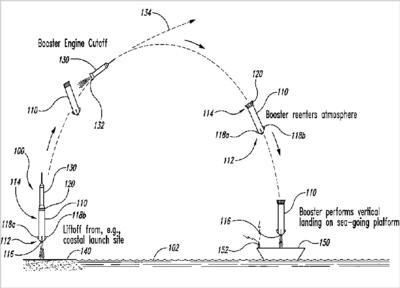Thu, Sep 04, 2014
Patent Filed For 'Sea Landing Of Space Launch Vehicles And Associated Systems And Methods'
SpaceX is challenging a patent awarded earlier this year to Blue Origin for a system designed to allow reusable rocket boosters to land on a floating platform in the ocean.

The Blue Origin patent describes the recovery of a booster that makes a soft landing on a floating platform or barge. SpaceX recently tested a booster that made a soft landing in the water, and its Grasshopper experiments have demonstrated the company's ability to make a soft landing on the ground.
The patent abstract describes "Launch vehicle systems and methods for landing and recovering a booster stage and/or other portions thereof on a platform at sea or on another body of water are disclosed. In one embodiment, a reusable space launch vehicle is launched from a coastal launch site in a trajectory over water. After booster engine cutoff and upper stage separation, the booster stage reenters the earth's atmosphere in a tail-first orientation. The booster engines are then restarted and the booster stage performs a vertical powered landing on the deck of a pre-positioned sea-going platform. In one embodiment, bidirectional aerodynamic control surfaces control the trajectory of the booster stage as it glides through the earth's atmosphere toward the sea-going platform. The sea-going platform can broadcast its real-time position to the booster stage so that the booster stage can compensate for errors in the position of the sea-going platform due to current drift and/or other factors. After
landing, the sea-going platform can be towed by, e.g., a tug, or it can use its own propulsion system, to transport the booster stage back to the coastal launch site or other site for reconditioning and reuse. In another embodiment, the booster stage can be transferred to another vessel for transport. In still further embodiments, the booster can be refurbished while in transit from a sea-based or other landing site."
According to SpaceRef Daily, SpaceX has filed two challenges to the patent. In one, the company holds that "The reusable launch vehicle techniques described in Section IV above were known to persons of ordinary skill in the art by at least the late 1990s, but this fact went largely unnoticed by the patent owner during the original prosecution of the '321 patent. The Background portion of the '321 patent pays lip service to the existence of prior art reusable launch vehicles (RLVs), but does not describe them in any detail. ('321 patent at 1:60-62.) Nor does the specification identify any specific drawback of existing RLVs that the alleged invention seeks to address. (Id.)
The '321 patent instead attempts to lay claim over the technique described by Ishijima in 1998 of landing a reusable space launch vehicle on a "sea-going platform," such as a "free-floating, ocean-going barge" or other vessel. ('321 patent at 5:14-20.)"
(Image from Blue Origin patent document)
More News
Aero Linx: International Federation of Airworthiness (IFA) We aim to be the most internationally respected independent authority on the subject of Airworthiness. IFA uniquely combi>[...]
Ultrahigh Frequency (UHF) The frequency band between 300 and 3,000 MHz. The bank of radio frequencies used for military air/ground voice communications. In some instances this may >[...]
A Few Questions AND Answers To Help You Get MORE Out of ANN! 1) I forgot my password. How do I find it? 1) Easy... click here and give us your e-mail address--we'll send it to you >[...]
From 2019 (YouTube Edition): Learning To Paint Without Getting Any On Your Hands PPG's Aerospace Coatings Academy is a tool designed to teach everything one needs to know about all>[...]
Also: Sustainable Aircraft Test Put Aside, More Falcon 9 Ops, Wyoming ANG Rescue, Oreo Cookie Into Orbit Joby Aviation has reason to celebrate, recently completing its first full t>[...]
 ANN's Daily Aero-Linx (05.06.25)
ANN's Daily Aero-Linx (05.06.25) ANN's Daily Aero-Term (05.06.25): Ultrahigh Frequency (UHF)
ANN's Daily Aero-Term (05.06.25): Ultrahigh Frequency (UHF) ANN FAQ: Q&A 101
ANN FAQ: Q&A 101 Classic Aero-TV: Virtual Reality Painting--PPG Leverages Technology for Training
Classic Aero-TV: Virtual Reality Painting--PPG Leverages Technology for Training Airborne 05.02.25: Joby Crewed Milestone, Diamond Club, Canadian Pilot Insurance
Airborne 05.02.25: Joby Crewed Milestone, Diamond Club, Canadian Pilot Insurance



